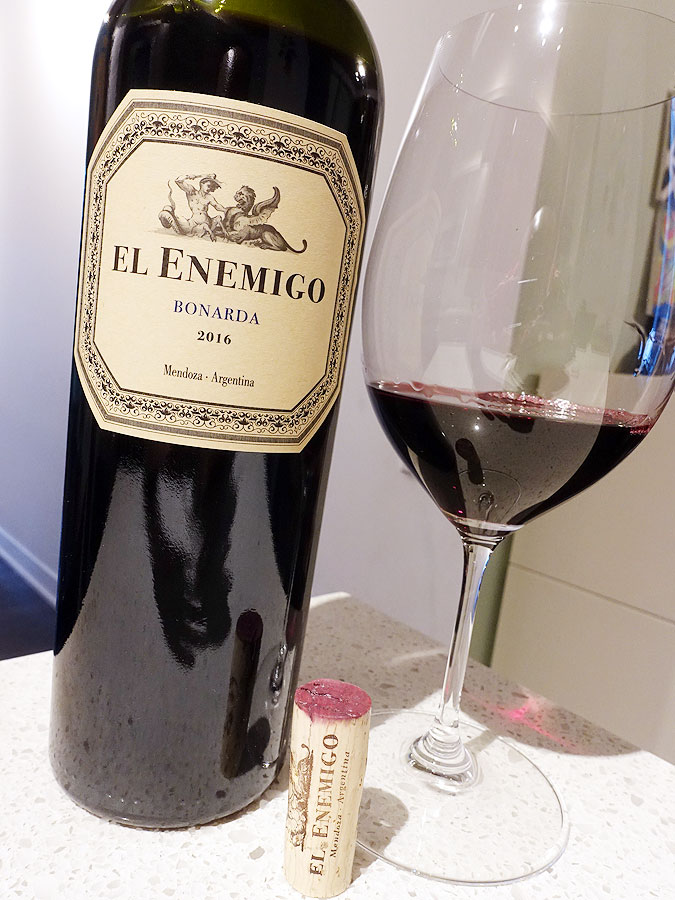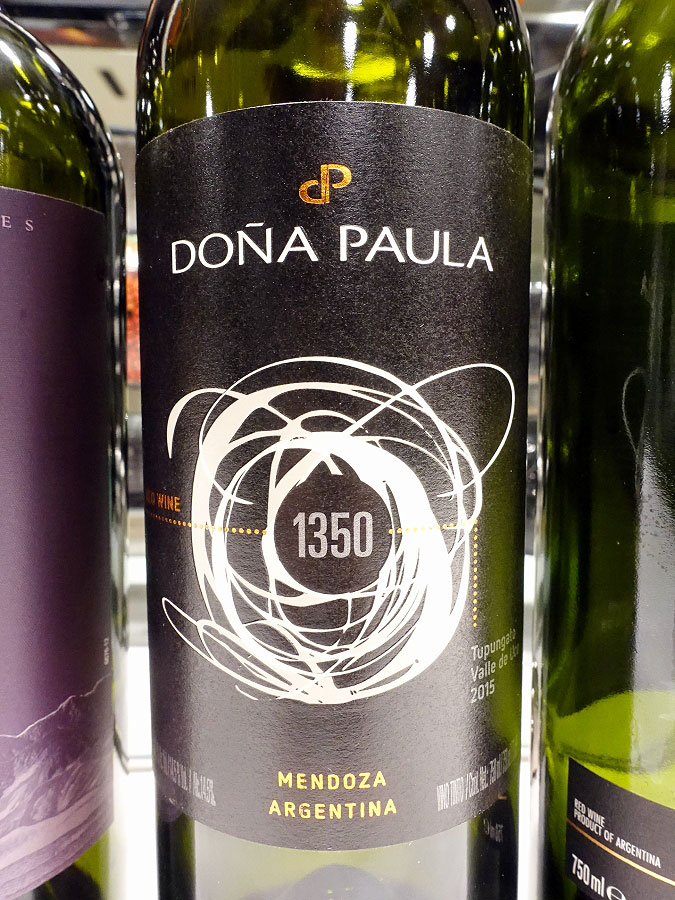To cap off a relaxing Thanksgiving Day long weekend, wine reviews are a pair of lovely Wines of Argentina by El Enemigo. Both of these delicious wines arrived in LCBO VINTAGES in July, and while there are still a few bottles available for purchase across Ontario, you may also be able to find these wines aplenty via their Agent - Noble Estates Wine & Spirits.
Winemaker Alejandro Vigil and Adrianna Catena (daughter of Nicolás Catena) created Bodega Aleanna (El Enemigo Wines) in 2008 and it appears as though the name "Aleanna" is a combination of their first names. The name El Enemigo translates to enemy. The wines of El Enemigo are a tribute to internal battles, an enemy, if you will, that make us who we are, and are brought to fruition by Alejandro and Adrianna by trying to capture the era when European immigrants first settled in Argentina and sought to make fine wines as good (or better) than those of their old homeland.
El Enemigo Wines are produced in the southern foothills of Maipu, Mendoza. The have a number of vineyards across Mendoza, a region known for its high-altitude vineyards in the foothills of the Andes Mountains. Alejandro is a soil expert, holding a Master's Degree in both winemaking and irrigation management, and has been the Winemaking Director at Bodega Catena Zapata since 2007. His strong scientific background led to important developments in both vineyard management and winemaking.
Chardonnay is the 2nd most widely planted white varietal in Argentina, however, it makes up just less than 3% of the total cultivated area in the country. This Chardonnay is from Mendoza, where more than 80% of all Chardonnay plantings are located. Moreover, Chardonnay is the most widely planted white wine varietal in Mendoza. And within the Tupungato GI, which is located in the Uco Valley of Mendoza, Chardonnay is considered to be one of the main grape varietals of the regions. Chardonnay is highly appreciated in Mendoza due to its ability to ripen well in the region and produce a wide range of elegant wines, such as this example from the high-altitude area of Gualtallary.
Until fairly recently, Bonarda was the most widely planted grape in Argentina. It was brought to Argentina by immigrants in the late 19th century. Today, it is the second-most cultivated varietal in Argentina, behind only Malbec. Bonarda is a thick-skinned, very late-ripening grape that is usually one of the last grapes to be harvested. It has much success in warmer climates, thus 60% of all Bonarda in Argentina is grown in the East of Mendoza, such as Rivadavia, where the climate is warmer at about 700 metres above sea level.
The last grape worth a mention in this post is Cabernet Franc, as it makes up 15% of the 2016 El Enemigo Bonarda. Cabernet Franc is not commonly grown in Argentina, making up just 1% of all red varietals cultivated in the country, placing it about 8th on the list. It is relatively new to Argentina as it was first planted in the 1990's and has adapted well to the high-altitude vineyards of Mendoza. Today, nearly 80% of all Cabernet Franc in the country is grown in Mendoza. Since there isn't much Cabernet Grown, it is mostly used in blends to give strength, although the grape does excel in quality on its own.
A naturally restless person, Alejandro strives to channel his creative energy into pushing
the limits of conventional viticultural and winemaking wisdom. As Alejandro says, "Winemaking is a way of life that revolves around contact with nature and a true love for the work. To produce wines from a place you need to breathe the same air as the vine, suffer the cold and the heat, and feel a sense of belonging to that place". Let's discover the wines of El Enemigo...
100% Chardonnay grown between 1,400 to 1,500 metres above sea level on calcareous, rocky soils. It was barrel-fermented using wild yeasts and spent 9 months in French oak with veil. The elegant, medium+ intensity nose offers ripe lemon citrus and apple with touches of banana, tropical fruit, and vanilla. It is almost full bodied on the creamy palate with lovely ripe lemon citrus, and apple, and banana replays joined by leesy and nutty tones. Notes of pink bubblegum add further interest on the slightly hot mid-palate that is juicy with mouth-watering acidity. Apple and lemon with a leesy-nutty aftertaste on the long finish. LCBO VINTAGES Wine of the Month. Score: 90 pts
EL ENEMIGO BONARDA 2016 - Mendoza, Argentina (#15120) (XD) - $24.95
An interesting blend of 85% Bonarda from El Mirador (Rivadavia) grown at 650 metres on sandy soils, and 15% Cabernet Franc from Gualtallary (Uco Valley) at high-altitude of 1,470 metres above sea level on calcareous, rocky soils. It was fermented using wild yeast and then aged for 15 months in 100 year old foudre. This has a fresh, medium-high intensity nose of dark berry, blackberry, plum, spices, and minty herb with savoury/meaty undertones and a fine streak of stony minerality. It is full-bodied on the ripe palate with dark berry, chocolatey oak, and spice flavours supported by fine, integrated tannins and balanced acidity. Some chalkiness on the mid-palate, while the long, satisfying finish has plummy, dark berry, and mineral notes. Arrived in LCBO VINTAGES . Score: 90 pts
Winemaker Alejandro Vigil and Adrianna Catena (daughter of Nicolás Catena) created Bodega Aleanna (El Enemigo Wines) in 2008 and it appears as though the name "Aleanna" is a combination of their first names. The name El Enemigo translates to enemy. The wines of El Enemigo are a tribute to internal battles, an enemy, if you will, that make us who we are, and are brought to fruition by Alejandro and Adrianna by trying to capture the era when European immigrants first settled in Argentina and sought to make fine wines as good (or better) than those of their old homeland.
El Enemigo Wines are produced in the southern foothills of Maipu, Mendoza. The have a number of vineyards across Mendoza, a region known for its high-altitude vineyards in the foothills of the Andes Mountains. Alejandro is a soil expert, holding a Master's Degree in both winemaking and irrigation management, and has been the Winemaking Director at Bodega Catena Zapata since 2007. His strong scientific background led to important developments in both vineyard management and winemaking.
Chardonnay is the 2nd most widely planted white varietal in Argentina, however, it makes up just less than 3% of the total cultivated area in the country. This Chardonnay is from Mendoza, where more than 80% of all Chardonnay plantings are located. Moreover, Chardonnay is the most widely planted white wine varietal in Mendoza. And within the Tupungato GI, which is located in the Uco Valley of Mendoza, Chardonnay is considered to be one of the main grape varietals of the regions. Chardonnay is highly appreciated in Mendoza due to its ability to ripen well in the region and produce a wide range of elegant wines, such as this example from the high-altitude area of Gualtallary.
Until fairly recently, Bonarda was the most widely planted grape in Argentina. It was brought to Argentina by immigrants in the late 19th century. Today, it is the second-most cultivated varietal in Argentina, behind only Malbec. Bonarda is a thick-skinned, very late-ripening grape that is usually one of the last grapes to be harvested. It has much success in warmer climates, thus 60% of all Bonarda in Argentina is grown in the East of Mendoza, such as Rivadavia, where the climate is warmer at about 700 metres above sea level.
The last grape worth a mention in this post is Cabernet Franc, as it makes up 15% of the 2016 El Enemigo Bonarda. Cabernet Franc is not commonly grown in Argentina, making up just 1% of all red varietals cultivated in the country, placing it about 8th on the list. It is relatively new to Argentina as it was first planted in the 1990's and has adapted well to the high-altitude vineyards of Mendoza. Today, nearly 80% of all Cabernet Franc in the country is grown in Mendoza. Since there isn't much Cabernet Grown, it is mostly used in blends to give strength, although the grape does excel in quality on its own.
A naturally restless person, Alejandro strives to channel his creative energy into pushing
the limits of conventional viticultural and winemaking wisdom. As Alejandro says, "Winemaking is a way of life that revolves around contact with nature and a true love for the work. To produce wines from a place you need to breathe the same air as the vine, suffer the cold and the heat, and feel a sense of belonging to that place". Let's discover the wines of El Enemigo...
Tasting Notes:
EL ENEMIGO CHARDONNAY 2017 - Gualtallary, Tupungato, Uco Valley, Mendoza, Argentina (#482984) (XD) - $23.95100% Chardonnay grown between 1,400 to 1,500 metres above sea level on calcareous, rocky soils. It was barrel-fermented using wild yeasts and spent 9 months in French oak with veil. The elegant, medium+ intensity nose offers ripe lemon citrus and apple with touches of banana, tropical fruit, and vanilla. It is almost full bodied on the creamy palate with lovely ripe lemon citrus, and apple, and banana replays joined by leesy and nutty tones. Notes of pink bubblegum add further interest on the slightly hot mid-palate that is juicy with mouth-watering acidity. Apple and lemon with a leesy-nutty aftertaste on the long finish. LCBO VINTAGES Wine of the Month. Score: 90 pts
EL ENEMIGO BONARDA 2016 - Mendoza, Argentina (#15120) (XD) - $24.95
An interesting blend of 85% Bonarda from El Mirador (Rivadavia) grown at 650 metres on sandy soils, and 15% Cabernet Franc from Gualtallary (Uco Valley) at high-altitude of 1,470 metres above sea level on calcareous, rocky soils. It was fermented using wild yeast and then aged for 15 months in 100 year old foudre. This has a fresh, medium-high intensity nose of dark berry, blackberry, plum, spices, and minty herb with savoury/meaty undertones and a fine streak of stony minerality. It is full-bodied on the ripe palate with dark berry, chocolatey oak, and spice flavours supported by fine, integrated tannins and balanced acidity. Some chalkiness on the mid-palate, while the long, satisfying finish has plummy, dark berry, and mineral notes. Arrived in LCBO VINTAGES . Score: 90 pts






























